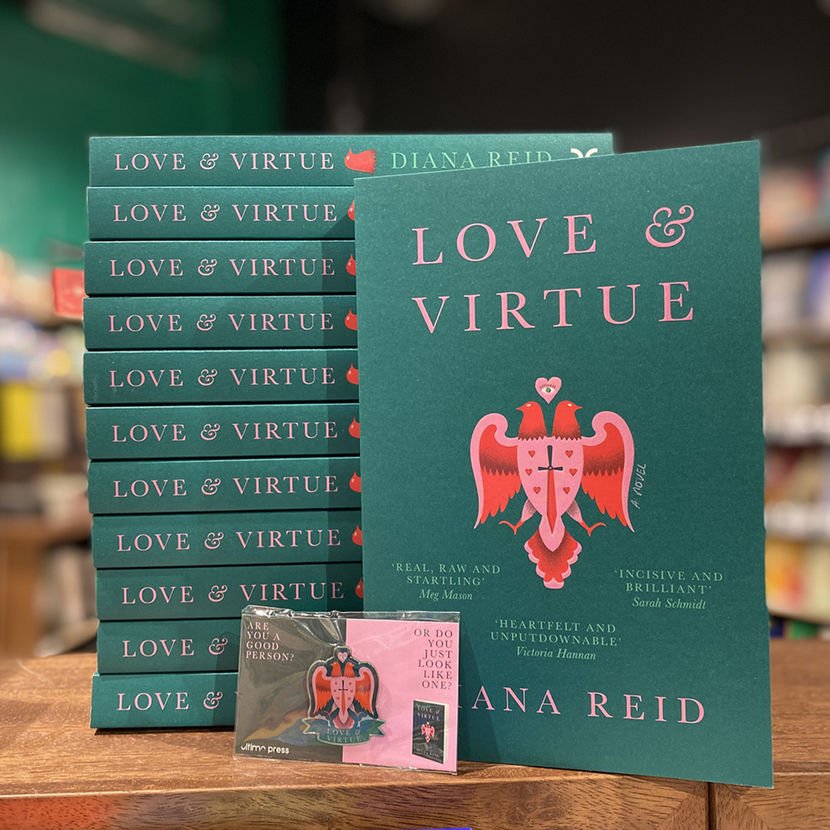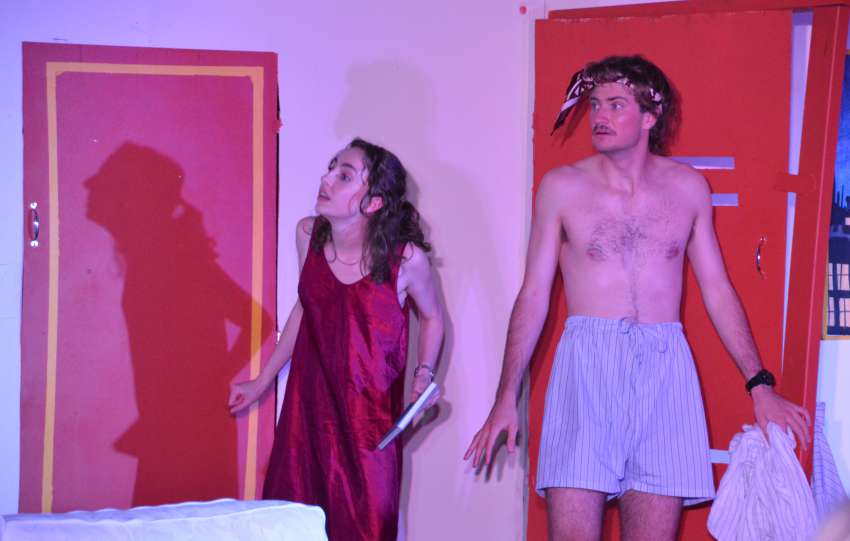Share This Article
Jules Vahl reviews Diana Reid’s new campus novel, Love and Virtue.
This review contains discussion of consent and sexual assault, which may trigger some readers.
According to my English lecturer last semester, it takes around sixty pages for a reader to fully immerse themselves in the world of a novel. It took only one page for Diana Reid’s debut novel Love and Virtue to captivate me entirely.
It’s a story for uni students, using the language of uni students, written by a (recently graduated) uni student. It’s also a story for College residents, with Reid capturing the full spectrum of the lived experiences which make College the place it is.
Love and Virtue follows Michaela, a bright and self-assured young woman, as she finds her feet in her first year at an unnamed university in Sydney. Michaela has won a scholarship to attend the all-female “Fairfax” College, where she struggles to reconcile her own modest upbringing with the exorbitant wealth of her Sydneysider friends.
During the year, she parties hard, studies little, meets plenty of boys at the all-male “St Thomas’ College” next to Fairfax, and gets a little too close to one of her university professors. Michaela also meets her neighbour Eve, who shares her moral discomfort with elements of College life. However, Eve’s desire to be perceived as virtuous and brilliant leads her to abuse Michaela’s personal experiences in a way which Michaela will never forgive.
You might get a whiff of reality from parts of this story – and you’d be right. To the trained eye, Reid’s setting is very explicit. She represents the USyd Colleges in an incredibly resonant, accurate and powerful way. As I progressed through the novel, I felt like I was having a gripping conversation with another College student, not an earnest lecture from a learned author. There were many moments where I thought to myself, “I know where that is,” or “So true!,” or “I’ve heard so many people say that,” or even “I know that.” Reid understands all the lingo and customs of the Colleges, which is what makes this book so enthralling.
Some highlights of Reid’s setting and form include:
- References to King Street including “Istanbul on King” (coincidence? I think not).
- Allusions to the Palladian competition and its questionable judging.
- “We’ve never met before, so I’m obliged to ask, (in order of importance), what school did you go to? What ATAR did you get? What degree are you doing?”
- “Debating is to Sydney Grammar what First XV rugby is to other schools.”
- Depictions of the Quadrangle.
- Depictions of formal dinners.
- Text messages between students throughout the novel.
- Scenes of St Thomas’ College ‘French-themed’ formal, including poodles and fireworks.
As you might anticipate, Reid’s portrayal of the Colleges is not always positive. She doesn’t hesitate to criticise the difficult issues that accompany college and university life. But it’s the exploration of characters and themes below that elevate Love and Virtue from a story about the shenanigans of drunk teenagers to a serious piece of moral and philosophical fiction.
Consent
The plot of Love and Virtue hinges on a Welcome Week equation that is troublingly clichéd: boy + girl + alcohol = sexual encounter which girl has hazy memory of = consent alarm bells ringing. In the current social climate, you might assume that Reid would portray St Thomas’ resident Nick as an entitled scumbag with a deep contempt for women.
But Nick isn’t that at all. In fact, Nick is one of the more reflective and thoughtful of the St Thomas’ College boys in the novel. He finds that many of his friends lack an ‘inner life’ and are blissfully unaware of their own privilege – a sentiment which Michaela agrees with.
Michaela has ambivalent feelings about her encounter with Nick: she doesn’t really know whether she consented or not, and dislikes being told how to feel by Eve. Michaela can sense Nick’s shame and guilt when their one night stand comes to light, and, without giving too much away, she has good reason to pity Nick by the end of the story. Reid’s narrative challenges the idea that consent is a black and white issue, by choosing to explore the grey areas that simmer under the surface.
Relationships
Michaela’s relationship with Nick is one of many complicated relationships in the novel. Mid-way through her first year, Michaela becomes romantically involved with her philosophy lecturer, Paul Rosen.
I had heard about this before I started reading the novel, and I was immediately drawn to prejudicial assumptions – surely he manipulated his position of power to get closer to her; surely he offered high marks in exchange for favours; surely this is exposing the university’s failure to manage teacher–student relationships.
I was wrong.
Michaela initiates the relationship with Paul, and enjoys it, misguided as it might seem. Paul’s apartment is an escape from the College world, a place of safety where Michaela thinks she can be herself. Paul is more dependable and supportive than most of Michaela’s College friends. Their relationship develops into an intellectual and emotional union, but they both know it can’t last for long. The question on the reader’s lips is, “does Michaela like Paul as he is, or because of the power and academic prowess he represents?” Reid leaves us to decide.
Although the origins of Michaela and Paul’s relationship are hard to swallow, Reid’s take pushes the boundaries in its nuance and ambiguity. Not every relationship between an older man and a younger woman is a black and white abuse of power, as Eve would have us believe.
Eve
The themes I have discussed so far are hard to separate from the university/college setting. However, there is one character who takes the novel from the campus to the universal: Eve.
Eve is a paradox: a social and political pioneer bent on damaging the institutions she was made by and continues to benefit from; an outspoken critic of ‘privileged’ people without acknowledging she is one; someone who wants to seem virtuous rather than compromise her own lifestyle; someone who uses others to validate their own beliefs rather than challenge them; someone who sees the mainstream narrative as a currency to be bought into and utilised, without recognising the nuances that make our stories personal.
Eve is still a charming person, but rooted within her is the question: “What am I?” She is not really her authentic self, but a construction of what she believes is most appealing to others. She is, in her own words, “an idea of a person.” Her desire for attention and self-validation will later drive her to an unspeakable betrayal of Michaela’s trust. Although Eve is not a character to aspire to, there is certainly a part of her in all of us – a preoccupation with perception, often to the detriment of our true selves.
Conclusion
The beginning of Love and Virtue greeted me with a famous piece of Latin (in translation) that perfectly captures what Reid achieves in the book: Esse Quam Videri [to be, rather than to seem]. Reid’s examination of mainstream narratives and the identities of young people interrogates the difference between seeming and being. Whether it be truth, love or virtue, Reid’s story constantly questions the authenticity of the values and beliefs we claim to have. In an era where “everyone is so sure what they think,” Reid sheds light on the ambiguity between seeming and being, the in-between space that we have neither the patience, nor the appetite, to think about.
After I finished this review, I reached out to Reid to elaborate further on her unique perspective on College. Here is a selection of her responses:.
Why is Love and Virtue an important read for college residents?
Hopefully it’s fun to read because the setting is so familiar. But I think it’s important to read because it explores the way that institutions can influence our moral thinking: how we look to what’s normal and socially acceptable in order to determine what’s right or wrong. I think this is true of institutions generally, so even if you don’t recognise your specific college or peers in Love & Virtue, hopefully it prompts you to ask: in what ways am I shaped by the institutions I inhabit?
What can female-identifying college residents learn from the relationship between Michaela and Eve?
Michaela and Eve are both incredibly ambitious and competitive, which means they push each other to greater heights, even while trying to drag each other down. It sounds strange, because their relationship is probably best described as “toxic”, but I hope that readers come away with an appreciation of the value of female friendship: the admiration that one woman can have for another, and the way that female friendships—even the ones that don’t last—can leave a profound mark.
What can college residents learn from the relationship between Michaela and Nick?
I’d hope that college residents learn how important it is to trust each other with their vulnerabilities and doubts. I don’t want to give too much away, but Michaela and Nick miss their opportunity to have an honest conversation. I think they’re both good people—or, at least, they’re people who care about trying to be good—who could have had a really positive impact on each other if they’d just found a way to communicate.
I suggest in my review that part of Eve’s character exists in all of us. What can we do about this? What values does Eve not have, that we should?
Haha, I certainly think we all have an Eve in us. I think Eve confuses being a good person with being better than other people. This can lead to muddied motivations: often she does the right thing, but for selfish reasons. We could all learn from her by counterexample—by spending less time worrying about how we are perceived, and more time trying to perceive the world around us in all its complexity (a very big task!).
Love and Virtue is available to purchase at all major booksellers.



